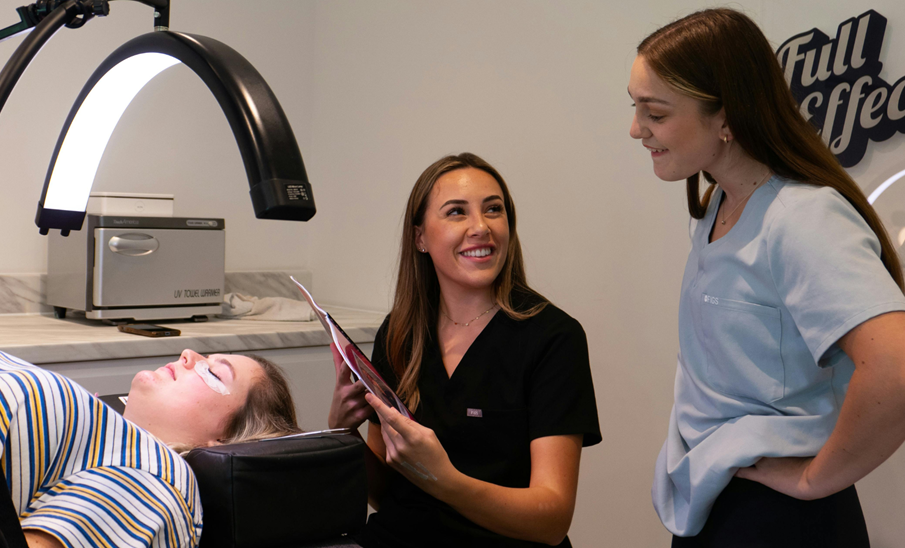Myths Patients Let Go Of After Seeing a Board-Certified Dermatologist

From social media “skinfluencers” to well-meaning friends, skincare advice is everywhere—and not always accurate. A single visit with a board-certified dermatologist often replaces guesswork with a plan grounded in science and your skin’s unique needs. Here are nine common myths patients leave behind once they’ve had a proper consult.
1) “If it tingles, it’s working.”
That spicy, burning sensation isn’t proof of effectiveness—it’s often a sign of irritation or barrier damage. Many active ingredients (retinoids, acids, vitamin C) can deliver results without discomfort when used at the right strength and cadence. Dermatologists tailor frequency (“retinoid 2–3 nights weekly,” “acid once weekly”) and pair actives with barrier support so progress doesn’t come at the cost of redness and peeling.
2) “Natural products can’t harm your skin.”
Poison ivy is natural, too. Plant extracts and essential oils can be surprisingly sensitizing, especially on compromised skin or after procedures. “Clean” labels don’t guarantee safety or compatibility. Dermatologists help you evaluate ingredients for your skin type, patch test when needed, and declutter routines that mix too many botanicals with strong actives—an under-recognized cause of chronic irritation.
3) “Sunscreen is only for sunny days.”
UV radiation penetrates clouds and windows; UVA (the ‘aging’ rays) is steady year-round and indoors by glass. Consistent daily SPF 30+ is the backbone of any regimen, post-procedure care, and hyperpigmentation management. Patients are often shocked how much smoother, brighter, and more even their skin looks after three to six months of diligent sun protection—often rivaling pricey treatments in visible payoff.
4) “Drugstore products don’t work.”
Price isn’t a proxy for performance. Many evidence-backed ingredients—adapalene, benzoyl peroxide, niacinamide, urea, petrolatum—are available at accessible price points with excellent data. Dermatologists prioritize formulations and tolerability, not hype. The right $12 moisturizer with ceramides and cholesterol can outperform a luxury cream if it suits your barrier and climate.
5) “You should exfoliate every day.”
Daily scrubbing and acid stacking may deliver short-term glow but often triggers rebound oiliness, sensitivity, and breakouts. Most complexions do best with strategic exfoliation (1–3 times weekly), separated from retinoid nights. A dermatologist helps you set a “maintenance rhythm” so you keep clarity without thinning the barrier—crucial for rosacea, melasma, and acne-prone skin.
6) “Diet doesn’t affect skin.”
While skin isn’t a simple reflection of your plate, patterns matter. Dermatologists commonly see improvements when patients moderate frequent high-glycemic spikes, emphasize protein and colorful produce, and address potential triggers (e.g., certain dairy types for some acne patients). No one-size-fits-all rule exists, but guided tweaks—plus sleep and stress care—often reduce flares and improve texture over time.
7) “More products = faster results.”
Layering six serums doesn’t multiply benefits; it multiplies variables. Overly complex routines make it hard to identify what’s helping or hurting. Many patients do better on a streamlined plan: gentle cleanse, targeted active (per schedule), barrier moisturizer, daily SPF. Dermatologists refine by season and response, increasing potency only when your skin shows it’s ready—not because a trend says so.
8) “Lasers and peels erase everything in one go.”
Energy devices and chemical peels are powerful, but they’re not magic erasers; they work best as part of a series with at-home maintenance. Collagen remodeling and pigment normalization happen over weeks to months. A dermatologist sets realistic timelines, stacks modalities safely (e.g., light resurfacing + pigment control), and pairs them with strict photoprotection to maintain gains. That’s also why dermatology before and afterslook so compelling: they capture cumulative, protocol-driven progress—not a single afternoon.
9) “Acne is just a teenage problem.”
Adult acne is common, especially in women navigating hormonal shifts, stress, or medication changes. The approach differs from teen acne: gentler actives, barrier-first routines, and targeted prescriptions (like spironolactone or topical retinoids) can make a decisive difference. Dermatologists also screen for acne mimickers (perioral dermatitis, folliculitis) so you’re not treating the wrong condition—another reason DIY fixes stall.
What Patients Gain After a Real Consult
- Clarity: Which diagnosis you have (sometimes more than one) and why your current routine helps or hinders it.
- Cadence: A schedule that your skin can actually tolerate—when to use retinoids, when to exfoliate, and when to pause.
- Continuity: A maintenance path for stable, long-term results instead of short, boom-and-bust cycles.
- Confidence: Fewer products, better fits, and measurable markers of progress (photos, symptom trackers, follow-up check-ins).
Practical Takeaways to Keep Your Skin on Track
- Wear SPF daily. Indoors near windows? Still counts. Reapply when exposed.
- Simplify before you optimize. Get your base routine reliable; add one variable at a time.
- Mind your barrier. If you’re stinging or flaking, downshift actives and increase moisturization.
- Document monthly. Same lighting, same angle. Small improvements add up and guide adjustments.
- Plan seasonally. Skin changes with climate; your regimen should, too.
- Ask questions. Bring your products to the visit; your dermatologist can fine-tune, not just prescribe.
Letting go of myths is liberating—your routine becomes calmer, your skin clearer, and your results more durable. With expert guidance and consistent habits, you can trade internet noise for a plan that’s personalized, sustainable, and genuinely effective.












